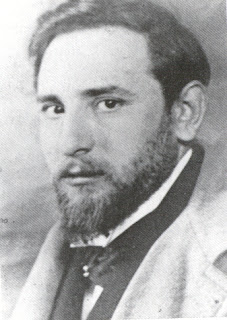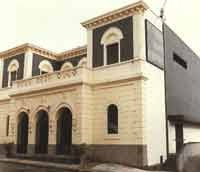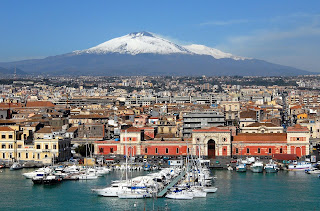Novelist and journalist with distinctive literary voice
The writer Giovanni Comisso, one of Italy’s most distinctive literary voices of the 20th century, was born on this day in 1895 in Treviso in the Veneto region..jpg)
Giovanni Comisso spent much of his
writing life travelling abroad
He was acclaimed for his novel Giorni di guerra - Days of War - which drew on his experiences serving as a telegraph engineer in the First World War. Comisso’s work won critical praise for being deeply attuned to the emotional and philosophical currents of his time.
For much of his life, Comisso led a peripatetic career as a journalist and art dealer, as well as a writer. He traveled extensively across Europe, North Africa, and the Far East, taking work as a correspondent for Italian newspapers such as Corriere della Sera and La Gazzetta del Popolo. For a while, he lived in Paris with the Italian painter Filippo De Pisis, leading what he described as a “disorderly and frenetic” existence within the city’s bohemian postwar artistic community.
Comisso was born into a comfortable, middle-class household, the son of an agricultural merchant. He attended the Antonio Canova classical high school in Treviso but failed his final exams and signed up for military service, taking a telegraph engineering course in Florence. By that time he had met Arturo Martini, a Trevisan sculptor six years his senior, with whom he developed a strong friendship. Martini helped him find a publisher for his first collection of poems, also painting his portrait for the cover.
In common with so many young Italian men, the course of Comisso's life abruptly changed with the outbreak of World War One. His service with the Telegraph Corps of Engineers took him to the front line in the war against Austria-Hungary. He took part in the Battle of Caporetto, a disastrous defeat for the Italians in November 1917, and the Battle of the Piave River in June 1918, a decisive victory that was probably the beginning of the end for Austria-Hungary.
Following the armistice, he was transferred to Fiume - the city that is now Rijeka in Croatia but to which Italy felt they had an historic claim. He was there in September, 1919, when a rebel army led by the Italian Army officer Gabriele D'Annunzio occupied the city in a response to what Italians perceived as the unfairness of post-war division of territory by their allies.
Comisso deserted and joined the rebel troops, an experience that deepened his fascination with rebellion and individualism. The occupation was short-lived but Fiume subsequently became part of Italy under the 1924 Treaty of Rome.
 |
| Giorni di guerra, the novel that drew on Comisso's war experience |
In the same year, Comisso completed the studies he had abandoned before WW1 and obtained a degree in law at the University of Siena. He never practised, instead combining travelling with writing, earning a living as a correspondent for a number of Italian newspapers and magazines. At different times, he ran a bookshop in Milan and was an art dealer in Paris.
Among his varied experiences, his time aboard a sailing ship based in Chioggia, at the southern end of the Venetian Lagoon, led him to write Gente di Mare - Seafarers - which won him the Bagutta Prize in 1929.
In December of that year, as a special correspondent for Corriere della Sera, he made the Grand Tour of the Far East, visiting China, Japan, Siberia, and Russia, which he travelled across to reach Moscow. His trip lasted seven months.
Back in Italy, he published his great wartime novel, Giorni di guerra, which initially caused him some problems with the Fascist regime, who were unhappy that it portrayed the Italian military in a raw, unheroic light.
Comisso used the money he had earned from his newspaper work and literature to buy a house and some land in Zero Branco, a town in the Treviso area, about 14km (nine miles) to the southwest of the city.
He published books of his writings in Paris and the Far East, although his travelling was not finished. The Gazzetta del Popolo, based in Turin, sent him on a tour of the entire Italian peninsula, from which he reported his observations, and then to East Africa to document the birth of the new Fascist Empire.
 |
| Comisso's final home in the village of Santa Maria del Rovere, on the outskirts of Treviso |
Meanwhile, his companion, Guido, with whom he shared his own home, was arrested by the Fascists, then released on condition that he joined a combat unit of the new Italian Social Republic, from which he deserted only to be shot dead by partisans, who suspected him of spying.
Comisso’s writing continued to be honoured. He won the Viareggio Prize in 1952 with Capricci italiani - Italian whims - and the Strega Prize in 1955 with Un gatto attraversa la strada - A Cat Crosses the Road - two collections of short stories.
After the deaths of his mother and both Arturo Martini and Filippo De Pisis, Comisso left Zero Branco to rent an apartment in Treviso, but moved again, to a house in Santa Maria del Rovere, on the outskirts of Treviso, where he continued to write.
His final work, a collection of stories entitled Attraverso il tempo - Through Time - was published just a few months before his death, in hospital in Treviso, in January 1969.
Comisso’s writing, distinguished by its lyrical prose, existential undertones, and a tension between rootedness and escape, left an indelible mark on Italian literature.
Travel tip:
The pretty Piazza dei Signori is the
square at the heart of Treviso
For many visitors to Italy, Treviso is no more than the name of the airport at which they might land en route to Venice, yet it is an attractive city worth visiting in its own right, rebuilt and faithfully restored after the damage suffered in two world wars. Canals are a feature of the urban landscape – not on the scale of Venice but significant nonetheless – and the Sile river blesses the city with another stretch of attractive waterway, lined with weeping willows. The arcaded streets have an air of refinement and prosperity and there are plenty of restaurants, as well as bars serving prosecco from a number of vineyards. The prime growing area for prosecco grapes in Valdobbiadene is only 40km (25 miles) away to the northeast. Treviso’s main sights include its historic squares, medieval walls, unique fountains, and art-filled museums. Piazza dei Signori is the heart of Treviso’s historic centre, a 13th-century square lined with elegant cafés, boutiques, and civic buildings. The city’s well-preserved walls date back to the 15th century and once protected the city. The Porta San Tomaso entrance to the city is a grand marble city gate from the 16th century, adorned with ornate carvings and the winged lion of Venice.
Hotels in Treviso from Hotels.com
Travel tip:
The National Theatre in Rijeka, where the
architecture bears a heavy Italian influence
Rijeka is a vibrant port city on Croatia’s northern Adriatic coast, yet between 1924 to 1947, it was known as Fiume and part of the Kingdom of Italy. During this period, Italian was the official language, and many public buildings, schools, and cultural institutions reflected Italian styles and values. Architecture flourished, with neoclassical and rationalist designs still visible today, especially in the city centre, while the Italian community thrived, contributing to Rijeka’s literary, musical, and culinary traditions. After World War II, the city was ceded to Yugoslavia, and many Italians left or were expelled. Yet traces of Italian heritage remain in street names and inscriptions, while many buildings still bear Italian influence. The city’s dual identity is reflected in its cuisine, blending Mediterranean and Central European flavours.
Find accommodation in Rijeka with Expedia
Also on this day:
The minister who persuaded Italy to switch sides in WW1
A poet who drew inspiration from the landscapes of the Veneto
How Gabriele d’Annunzio influenced Mussolini
Also on this day:
1808: The birth of record-breaking Palio jockey Francesco Bianchini
1858: The birth of actress Eleonora Duse
1938: The birth of world champion boxer Alessando Mazzinghi
1941: The birth of bass-baritone star Ruggero Raimondi
,_RP-P-1909-4600.jpg)
.png)


.jpg)










-panorama_novembre_2019.jpg)


_b.jpg)











